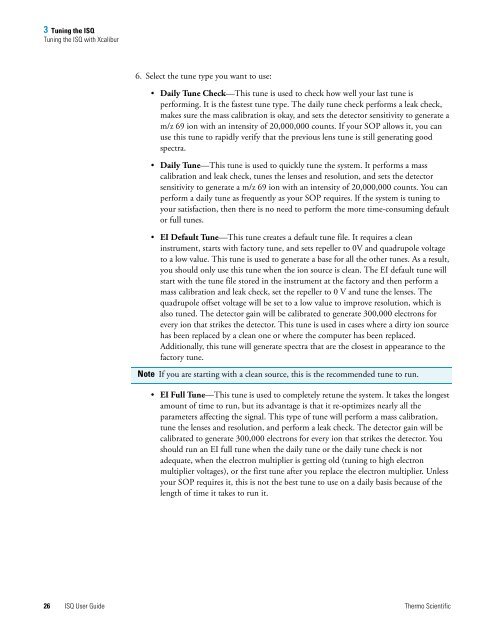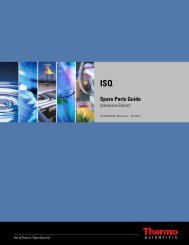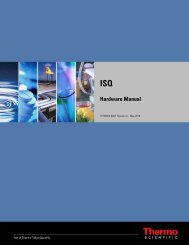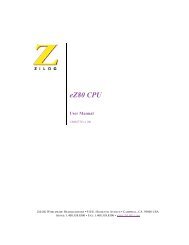ISQ User Guide - Write Frame of Mind
ISQ User Guide - Write Frame of Mind
ISQ User Guide - Write Frame of Mind
You also want an ePaper? Increase the reach of your titles
YUMPU automatically turns print PDFs into web optimized ePapers that Google loves.
3 Tuning the <strong>ISQ</strong><br />
Tuning the <strong>ISQ</strong> with Xcalibur<br />
6. Select the tune type you want to use:<br />
• Daily Tune Check—This tune is used to check how well your last tune is<br />
performing. It is the fastest tune type. The daily tune check performs a leak check,<br />
makes sure the mass calibration is okay, and sets the detector sensitivity to generate a<br />
m/z 69 ion with an intensity <strong>of</strong> 20,000,000 counts. If your SOP allows it, you can<br />
use this tune to rapidly verify that the previous lens tune is still generating good<br />
spectra.<br />
• Daily Tune—This tune is used to quickly tune the system. It performs a mass<br />
calibration and leak check, tunes the lenses and resolution, and sets the detector<br />
sensitivity to generate a m/z 69 ion with an intensity <strong>of</strong> 20,000,000 counts. You can<br />
perform a daily tune as frequently as your SOP requires. If the system is tuning to<br />
your satisfaction, then there is no need to perform the more time-consuming default<br />
or full tunes.<br />
• EI Default Tune—This tune creates a default tune file. It requires a clean<br />
instrument, starts with factory tune, and sets repeller to 0V and quadrupole voltage<br />
to a low value. This tune is used to generate a base for all the other tunes. As a result,<br />
you should only use this tune when the ion source is clean. The EI default tune will<br />
start with the tune file stored in the instrument at the factory and then perform a<br />
mass calibration and leak check, set the repeller to 0 V and tune the lenses. The<br />
quadrupole <strong>of</strong>fset voltage will be set to a low value to improve resolution, which is<br />
also tuned. The detector gain will be calibrated to generate 300,000 electrons for<br />
every ion that strikes the detector. This tune is used in cases where a dirty ion source<br />
has been replaced by a clean one or where the computer has been replaced.<br />
Additionally, this tune will generate spectra that are the closest in appearance to the<br />
factory tune.<br />
Note If you are starting with a clean source, this is the recommended tune to run.<br />
• EI Full Tune—This tune is used to completely retune the system. It takes the longest<br />
amount <strong>of</strong> time to run, but its advantage is that it re-optimizes nearly all the<br />
parameters affecting the signal. This type <strong>of</strong> tune will perform a mass calibration,<br />
tune the lenses and resolution, and perform a leak check. The detector gain will be<br />
calibrated to generate 300,000 electrons for every ion that strikes the detector. You<br />
should run an EI full tune when the daily tune or the daily tune check is not<br />
adequate, when the electron multiplier is getting old (tuning to high electron<br />
multiplier voltages), or the first tune after you replace the electron multiplier. Unless<br />
your SOP requires it, this is not the best tune to use on a daily basis because <strong>of</strong> the<br />
length <strong>of</strong> time it takes to run it.<br />
26 <strong>ISQ</strong> <strong>User</strong> <strong>Guide</strong> Thermo Scientific






